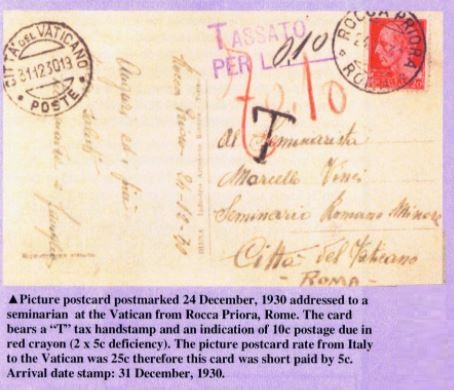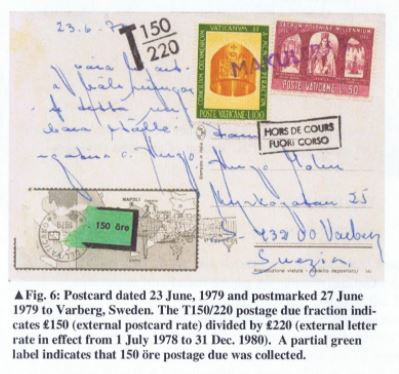
Daily
|
| Nothing, simply process the mailed item |
| Regular Stamps Were Applied With Markings |
| Handstamp Tassato (Taxed) and Amount Due Was Applied |
| Send Notice To Appear at Post Office to Pay the Past Due Fee |
Your answer was: Handstamp Tassato (Taxed) and Amount Due Was Applied. |
Answer: Greg Pirozzi presents the answer to this question in his Vatican Notes article "Early Vatican Postage Due Handstamp: Update" (1st article below). According to the examples in the article, a handstamp "Tassato per ____" was applied with the postage due amount being handwritten (see first example below). All examples that Greg presented in this article were with Italian stamps indicating the post office of origin was in Italy. In an earlier article (2nd article below), Greg had presented Vatican City postage due examples where a capital "T" handstamp with handwritten postage amounts (see the second example below). The "T" handstamp for Taxed is a common post office practice for handling postage due payments. These examples were Vatican City in origin but of a later date. See both articles cited below for additional information. If anyone has other examples, especially where Vatican City is the post office of origin, please contact us through the VPS Contact Page. Links to Greg's articles: • Greg Pirozzi, Early Vatican Postage Due Handstamp: Update Vatican Notes, Volume 58, Issue 345, 2010, Page 27 • Greg Pirozzi, Postage Due Markings on Vatican Postcards Vatican Notes, Volume 58, Issue 343, 2010, Page: 24-26  from Vatican Notes  from Vatican Notes |